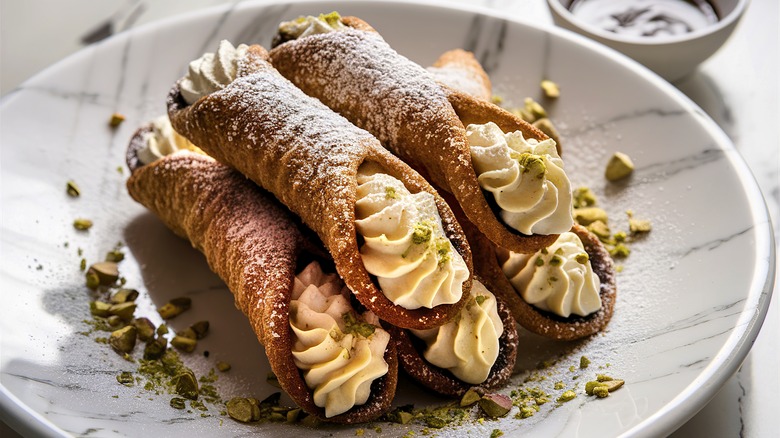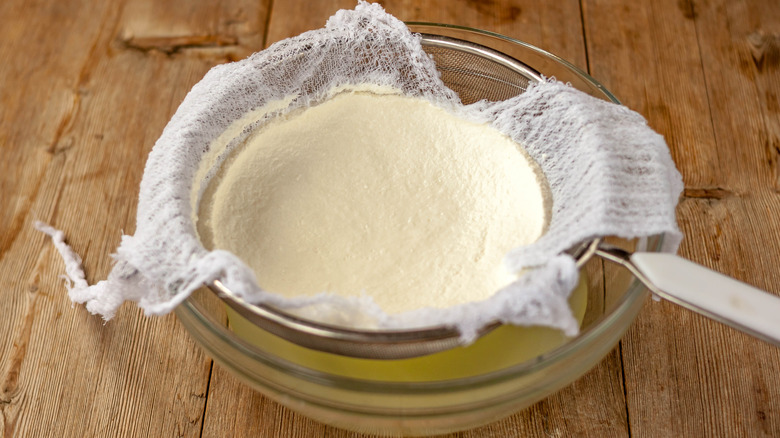What's Really In Cannoli Filling?
Cannoli (plural of cannolo) are a classic Italian dessert that showcase the irresistible combination of a crunchy shell and creamy filling. You can find them everywhere from specialty bakeries to grocery stores, and served after meals or at the breakfast table with a cup of espresso. Since they are a relatively simple dessert, it's imperative to nail the filling.
Cannoli are believed to have originated in the Palmero and Messina regions of Sicily during the time of the Moors. These treats were even previously named cappelli di turchi, "Turkish hats," harking back to the Arabic influence behind the recipe. Over the centuries, cannoli have evolved into a crunchy pastry shell traditionally stuffed with a mixture of ricotta, powdered sugar, and typically a main flavoring like cinnamon or citrus fruits. Today, this sweet is common across Italy and is particularly popular during the holidays of Carnevale and Christmas.
The cannoli shells are a pretty standard dough recipe without much divergence amongst regions or households, but the filling varies greatly depending on who is making it and where. The traditional Italian filling base is sheep's milk ricotta, but it's also common in the United States to use cow's milk ricotta or even the ever versatile mascarpone. The latter, which became the norm for Italian immigrants who couldn't find sheep ricotta stateside, can be used for the entirety of the filling (like in these homemade pistachio cannoli) or half-and-half with ricotta. Then, the mixture is flavored as desired with spices, nuts, fruits, and extracts, before being piped into the shells.
Customizing your cannoli filling
You can customize your cannoli filling for any season or holiday. Typical cannoli flavorings include cinnamon with vanilla or a more citrus-y take on the filling with lemon or orange zest. You can also add in a dash of citrus juice or extract to amp up the fruity flavors. Beyond those options, look to almond extract to create nutty notes or peppermint to add a wintery twist to your cannoli filling.
Once you've figured out the main flavor of your cannoli filling, it's time for the fun part of mix-ins. Many cannoli feature chocolate chips, and it's ideal to use miniature chocolate chips instead of regular size, as the mini variety will pass through a pastry filling bag much easier. If small chocolate chips aren't available, or you want a more elegant look, chocolate shavings are a delicious option too. Beyond the world of chocolate, other tasty mix-ins include chopped nuts (like pistachios) or candied fruits (such as citrus peels).
You can make your own cannoli shells at home, buy them frozen from an Italian grocery store, or even use ice cream cones as a cannoli shortcut. No matter which type you choose, your shells can be customized before serving. They can be drizzled or dipped in chocolate for a smooth texture. The ends may be rolled in any desired toppings, including mini chocolate chips, sprinkles, or finely chopped nuts. Finish off with a little dusting of powdered sugar and you're ready to serve the cannoli.
Tips for making the best cannoli filling
Cannoli filling is typically made with sheep's milk ricotta, which can often be found at well-stocked or Italian grocery stores. Whether you're using that or cow's milk ricotta, be sure to opt for the full-fat whole variety, as that will result in a thicker and richer filling. Place the cheese in a lined colander to drain for at least 30 minutes (or ideally overnight in the fridge) to remove any excess moisture. The result will be a cannoli filling that is extra creamy without being overly wet.
While your ricotta is draining, place your mixing bowl and mixer attachments (or whisk) into the fridge to chill. Keeping the tools cold will prevent the cheeses from separating and becoming mealy when whipping together the cannoli filling. Make sure that you're using powdered sugar in the mixture, not granulated, as that can also lead to a gritty texture. All out of confectioner's sugar? You can easily grind your own powdered sugar at home for an easy substitute.
Once you've made your delicious cannoli filling, you have about three days to use it up. The mixture doesn't freeze well, so if you've overdone it on the filling then it's time to get creative. Leftovers can be stuffed into cookies for sweet sandwiches, used as a cake filling, or even served as a dessert dip with pizzelle cookies for scooping.
Static Media owns and operates Tasting Table and Food Republic.



